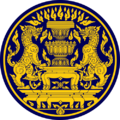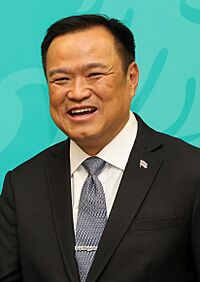Prime Minister of Thailand facts for kids
Quick facts for kids Prime Minister of the Kingdom of Thailand |
|
|---|---|

Prime Ministerial Standard
|
|

Prime Ministerial Seal
|
|
|
|
| Style |
|
| Member of |
|
| Reports to | National Assembly |
| Residence | Phitsanulok Mansion |
| Seat | Government House |
| Nominator | Speaker of the House of Representatives (By a majority vote of the House of Representatives) |
| Appointer | Monarch by royal command |
| Term length | No more than eight years in total |
| Constituting instrument | Constitution of Thailand |
| Formation | 28 June 1932 |
| First holder | Manopakorn Nitithada |
| Deputy | Deputy Prime Minister |
| Salary | ฿125,590 per month ($3,676 USD) |
The Prime Minister of Thailand (Thai: นายกรัฐมนตรี, RTGS: Nayok Ratthamontri) is the main leader of the government in Thailand. This important person also leads the group of top government officials called the Cabinet. The role of Prime Minister started in 1932. This was when Thailand changed from being ruled by a king with absolute power to a constitutional monarchy. In a constitutional monarchy, the king's power is limited by a constitution.
Currently, Anutin Charnvirakul is the Prime Minister of Thailand. He took office on 7 September 2025. Before him, there were some changes in leadership. For example, Paetongtarn Shinawatra served as Prime Minister from August 2024 until August 2025. She was removed from office following a decision by the Constitutional Court. During the time between prime ministers, other officials like Suriya Juangroongruangkit and Phumtham Wechayachai served as acting Prime Ministers for short periods.
Contents
Understanding the Prime Minister's Role
The Prime Minister of Thailand is like the chief manager of the country. They are in charge of making sure the government runs smoothly. This role is very important for leading the nation.
How Thailand's Government Changed
Before 1932, kings ruled Thailand with complete power. They were both the head of the country and the government. But in 1932, a peaceful change happened. Thailand became a parliamentary democracy. This meant the country would have a parliament and a Prime Minister.
The first Prime Minister of Siam (as Thailand was called then) was Phraya Manopakorn Nititada. He was a judge. The title of the office changed to "Prime Minister of Thailand" in 1949. This happened when the country's name officially changed to Thailand.
Key Facts About Past Prime Ministers
Many Prime Ministers in Thailand's history have been military leaders. The longest-serving Prime Minister was Plaek Phibunsongkhram. He held the position for almost 15 years. The shortest-serving Prime Minister was Thawi Bunyaket, who served for only 18 days. Thailand also had its first female Prime Minister, Yingluck Shinawatra, in 2011. Paetongtarn Shinawatra was the youngest Prime Minister at 37 years old.
The current rules say a Prime Minister can serve for no more than eight years in total. This rule helps ensure that power is shared over time.
Choosing the Prime Minister
The Prime Minister is chosen by the House of Representatives. This is one part of Thailand's parliament.
The Appointment Process
First, a candidate for Prime Minister needs support from many members of the House of Representatives. Then, the House votes. If a candidate gets a majority of votes, their name is sent to the King. The King then formally appoints the person as Prime Minister. This process usually happens after a national election. The person chosen is often the leader of the largest political party or a group of parties.
What the Prime Minister Does
The Prime Minister has many important jobs. They lead the Cabinet and represent Thailand to other countries.
Leading the Government
The Prime Minister is the leader of the Cabinet. They help choose and remove other government ministers. This means the Prime Minister is responsible for how well the government works. They also make sure the government's plans are announced to the National Assembly.
Managing Key Departments
The Prime Minister also oversees several important government departments. These include:
- The National Intelligence Agency
- The Bureau of the Budget
- The Office of the National Security Council
- The Office of the Civil Service Commission
All new laws about money that are introduced in the National Assembly need the Prime Minister's approval.
Removing a Prime Minister
Sometimes, a Prime Minister can be removed from office. This can happen through a "vote of no confidence." If enough members of the House of Representatives vote against the Prime Minister, they can be removed. This process cannot happen too often in one parliamentary session.
Where the Prime Minister Works and Lives
The Prime Minister has special offices and an official home.
The Prime Minister's Office
The Prime Minister works at the Government House of Thailand in Bangkok. This building is where many important government meetings happen. The Prime Minister also has a special department called the Office of the Prime Minister. This office helps the Prime Minister with their daily tasks.
The Official Residence
The official home for the Prime Minister is the Phitsanulok Mansion. It is also in Bangkok. This mansion was built a long time ago during the reign of King Vajiravudh. It became an official residence in 1979. Interestingly, some people say the mansion has ghosts! Because of this, many Prime Ministers choose to live in their own homes and only use the mansion for official events.
Deputy Prime Ministers
Thailand also has several Deputy Prime Ministers. These officials help the Prime Minister with their duties. They can also hold other important roles in the government, like leading a ministry.
List of Prime Ministers
Flags of the Prime Minister
See also
 In Spanish: Primer ministro de Tailandia para niños
In Spanish: Primer ministro de Tailandia para niños
- List of prime ministers of Thailand
- Constitution of Thailand
- Government of Thailand
- Office of the Prime Minister (Thailand)
- Cabinet of Thailand




